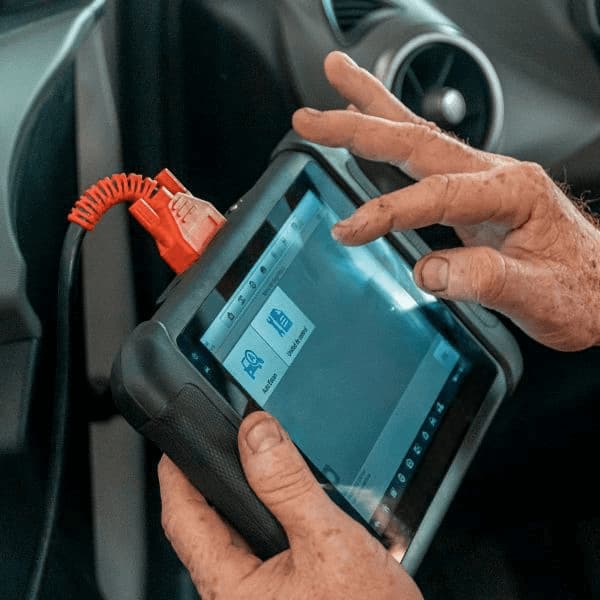If you own a car, you may have heard of an OBD reader. OBD stands for "On-Board Diagnostic" and is a tool that helps diagnose problems with your car's engine by interpreting the error codes stored in the on-board computer. In this article, we'll explain how to use an OBD reader to find problems with your car and save money by carrying out repairs yourself.
What is an OBD / OBD2 diagnostic reader?
An OBDII reader is a tool that allows you to solve your vehicle's engine problems by deciphering the error DTCs accumulated in the on-board computer. It comes in the form of a scanner, cable or box that connects to your car's OBD interface. The OBD2 interface on your car or motorbike is a connector that is generally located under the dashboard of your car.
OBDII readers come in a variety of shapes and sizes, but the most popular are Bluetooth OBD2 readers, which connect wirelessly to your smartphone or laptop via Bluetooth or Wi-Fi. There are also OBD2 readers that connect via a USB cable.
How do I use a Bluetooth / WIFI OBD2 reader?
To use an OBD-II reader, follow these steps:
- Connect the OBD-2 reader to your car's OBDII interface: most cars manufactured after 1996 are equipped with an OBD2 interface, but it's important to check your car's owner's manual to determine the type of connector you need.
- Install the compatible application on your smartphone or computer: to use a Bluetooth OBD reader, you need to download a diagnostic application that is compatible with your device. The most popular applications are Torque Pro for Android and Car Scanner for iOS.
- Connect the OBD reader to your smartphone or computer: once the application has been installed, you need to connect the OBD reader to your device. For a Bluetooth OBDII reader, you need to activate the Bluetooth link on your smartphone or computer and pair the OBD reader with your device. For an OBD reader with a USB cable, simply plug the cable into your computer.
- Read error codes: once the OBD reader is connected to your device, you can launch the diagnostic software to read the errors stored in your car's on-board computer. The error DTCs give you an indication of the underlying problem and help you determine the best way to solve it.
- Perform diagnostics: depending on the error codes you have read, you can perform diagnostics to determine the cause of the problem. Some error DTCs are easily resolved by carrying out minor repairs, while others require the intervention of a professional.
What are the benefits of an OBD reader for your vehicle?
An OBD reader has many advantages for car owners. Here are some of the most important benefits:
- Save money: by using an OBD reader to diagnose problems with your car, you can save money by carrying out repairs yourself. You won't need to pay expensive diagnostic fees to a garage.
- Save time: by using an OBD reader, you can immediately identify the problem with your car, saving time by avoiding unnecessary visits to the garage.
- Increased knowledge of your car: by using a reader, you can learn to understand your car better and diagnose problems more easily. This can help you solve minor problems quickly before they become major ones.
- Multi-make compatibility: OBDII readers are available for several makes of car. This means you don't need to buy a specific diagnostic tool for every model of car you own.
- Ease of use: OBD readers are very easy to use and do not require advanced technical skills. The diagnostic applications are also very user-friendly and easy to navigate.
- Reading fault DTCs: the fault codes stored in your car's on-board computer can provide valuable information about potential engine problems. OBD readers allow you to read these fault codes and determine the underlying cause of the problem.
How do I choose the right OBD fault code reader?
There are many types of OBDII reader on the market, so it's important to choose the one that best suits your needs. Here are some factors to consider when buying an OBD reader:
- The make of your car: some makes of car require a specific diagnostic tool. So make sure the OBD reader you buy is compatible with your make of car.
- The type of connection: Bluetooth OBDII readers are practical, as they allow you to connect wirelessly to your smartphone or computer. OBD readers with USB cables are also effective, but require a physical connection.
- Features: some OBD readers are equipped with additional features, such as car performance measurement and emissions monitoring.
- Reliability: it's important to choose a reliable, high-performance OBD reader to avoid diagnostic errors.
- Price: OBD readers are available at different prices. It's important to find an OBD reader that suits your budget, while offering the functionality you need.
Conclusion
An OBD reader is an essential automotive diagnostic tool that can help you save money and better understand how your car works. By using an OBDII reader, you can quickly identify problems with your car's engine and take the necessary steps to resolve them. When buying your OBD reader, make sure you choose the one that best suits your needs, depending on the make of your car, the type of connection, features, reliability and price. With a good OBD reader, you can diagnose your car's problems with confidence and make sure it's running at its best.

